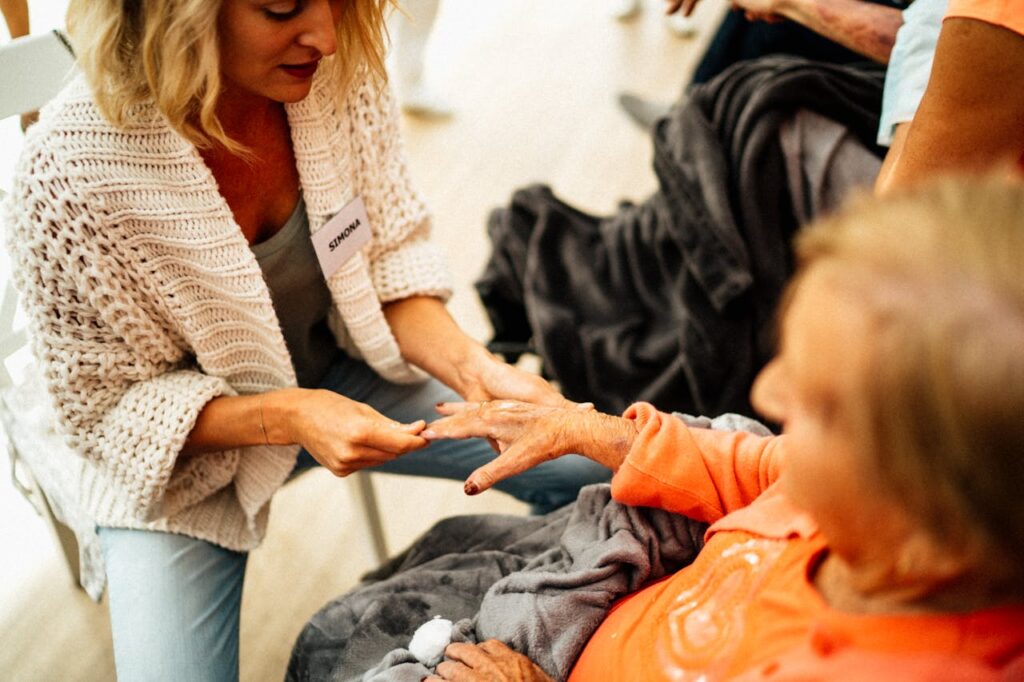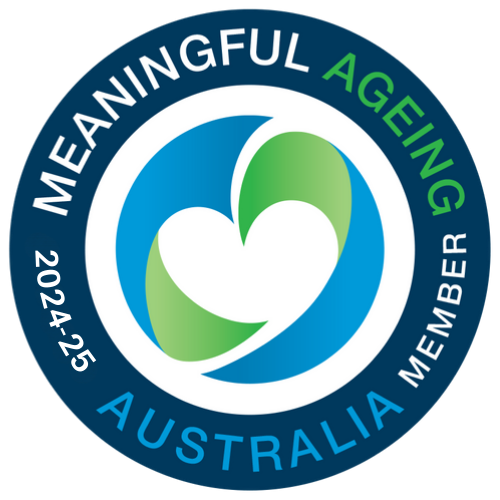Choosing the right dressing for senior wound care is crucial. Seniors are more likely to get chronic wounds because of changes that come with aging, such as fragile skin and slower healing rates. As such, proper wound care needs careful attention, as mishandling wounds can delay recovery and raise the risk of complications for older adults.
We understand the frustration and anxiety that accompany senior wound care. From pressure ulcers to diabetic wounds, each type of wound has its own challenges. Using the wrong dressing can increase discomfort, slow down healing, or lead to extra problems. With so many options available, how do you choose the best dressing for elderly skin tears to make sure your senior clients or loved ones get the right care?

After reading this guide, you’ll have a better understanding of the:
- Importance of choosing the right dressing for elderly wound care
- Different types of dressings and how they are used
- Factors to consider when assessing the wound and choosing the dressing
Armed with this knowledge, you’ll be equipped to make informed decisions that promote healing, enhance comfort, and improve the overall quality of life for your senior patients or loved ones.
Why the Right Dressing Matters for Elderly Wound Care
Selecting the right dressing for wound care in the elderly is crucial due to their skin’s increased fragility and slower healing process. The appropriate dressing not only accelerates healing by maintaining a moist environment and protecting against infection but also ensures the patient’s comfort and reduces the risk of further injury. This careful choice impacts not just the physical healing of the wound but also significantly enhances the overall well-being and quality of life for elderly individuals, making it a vital aspect of their care.
The Challenge of Elderly Skin
The skin of elderly individuals undergoes significant changes over time. It becomes thinner, less elastic, and more prone to damage. These changes make elderly skin particularly vulnerable to wounds, such as skin tears, which can occur from minor bumps or scrapes. Understanding these unique challenges is crucial for effective wound care, as it influences the choice of dressing and care strategies.
Here are some skin changes related to aging:
- It becomes thinner and more delicate.
- The blood vessels in the deeper layers of your skin decrease.
- Your skin makes less collagen, a protein that keeps it firm.
- The layers of your skin stick together less.
- Fat moves around in your skin.
- You might feel less sensation in your skin.
- Your skin produces less sweat.
Importance of Choosing the Right Dressing
The right dressing does more than just cover a wound. It creates an environment conducive to healing, protects against infection, and ensures comfort for the senior. A poorly chosen dressing can lead to delayed healing, discomfort, and even complications such as infections. Therefore, selecting an appropriate dressing is a critical step in promoting the health and well-being of elderly patients.
Choosing the right dressing for wounds offers several benefits, including:
- Promoting faster healing: Proper dressings can facilitate the wound healing process by creating an optimal environment for tissue regeneration.
- Preventing infection: The right dressing acts as a barrier against bacteria and other pathogens, reducing the risk of infection.
- Managing moisture: Dressings help maintain an appropriate level of moisture in the wound bed, which is crucial for healing and preventing complications such as maceration or excessive dryness.
- Supporting debridement: The right dressing can aid in removing dead tissue (debridement), promoting healthy tissue growth and reducing the risk of infection.
- Reducing pain: Certain dressings protect nerve endings, minimising pain and discomfort associated with the wound.
- Enhancing patient comfort: Choosing the right dressing can improve patient comfort by minimising irritation and maximising mobility.
- Customising care: Different types of wounds may require specific dressings tailored to their characteristics and stage of healing, allowing for personalised and effective wound management.
Choosing the Best Dressing for Skin Tear in the Elderly
Choosing the best dressing for skin tears in the elderly requires careful consideration of the wound’s characteristics and the unique needs of fragile senior skin. Skin tears, a common issue among the elderly due to their thinner, more delicate skin, need dressings that can provide a moist healing environment, minimise pain, and reduce the risk of further injury.
Assessing the Wound
Effective wound care begins with a thorough assessment of the wound. Consider the size, depth, and amount of exudation from the wound. This assessment will guide the selection of the most suitable dressing. For instance, a highly exuding wound may require an absorbent foam dressing, while a dry, shallow wound might benefit from a hydrocolloid or film dressing.
Furthermore, before selecting a wound dressing, it’s crucial to check for factors that could affect which dressing to use. Make sure to address these if they’re present:
- How the injury happened
- Risk of contamination
- Possible damage to deeper tissues
- Any nerve or tissue damage underneath
- Blood circulation problems
- Swelling of tissues
- Tetanus vaccination status
- Amount of tissue lost
- Signs of infection
Assessing the Dressing to Be Used
Knowing when to use specific types of wound dressings depends on several factors, including the type of wound, its healing stage, and its location. While superficial wounds can often be with basic dressings like gauze and bandages, deeper wounds may require more advanced options such as foam or alginate dressings.
For superficial wounds, traditional dressings like gauze and bandages are commonly used. However, these may stick to the wound and cause discomfort when removed. As such, applying a wound-healing gel or topical cream in addition to these dressings is advisable to maintain a moist environment conducive to healing.
For deeper wounds, especially those at risk of infection, specialised dressings may be necessary. The choice of dressing depends on factors such as wound secretion, drainage needs, and the presence of infection.
Specific types of wounds may require tailored dressings for optimal care:
- Chronic wounds often benefit from collagen dressings.
- Infected wounds may be treated with silver dressings.
- Burn wounds typically require specialised dressings for cooling and pain relief.
- Pressure ulcers can be managed with dressings that alleviate pressure on the affected area.
- Surgical wounds require dressings that facilitate healing and prevent infection.
- Traumatic wounds may need specialised dressings to aid tissue regeneration.
- Diabetic foot ulcers may also need special dressings to promote healing and avoid infection.
Types of Dressings Suitable for Elderly Wound Care
In elderly wound care, the choice of dressing plays a pivotal role in ensuring effective healing and comfort. The skin’s diminished elasticity and moisture retention capacity necessitate dressings that can provide optimal conditions for wound healing while minimising discomfort and the risk of further injury.
Gauze Dressings
Gauze dressings are a common type of wound dressing made from woven cotton or synthetic fibers. Gauze dressings can be used alone or with other dressings to soak up wound fluid (also called exudate) and protect the wound.
Advantages:
- They are versatile, affordable, and easy to find, so they’re often chosen for wound care.
Disadvantages:
- Gauze is not moisture retentive.
- Changing the gauze risks “non-selective debridement, ” essentially removing any new skin tissue forming during the wound healing process.
- Prone to bacterial contamination, so you need a secondary dressing.
- Not suitable for severe wounds because they can dry out and stick to the skin, which can slow down healing and cause more problems.
Preferred for:
Wounds that are minor, clean, and need protection or absorption of minimal exudate.
Applications:
- Covering and protecting minor wounds, such as scrapes or cuts.
- Soaking up wound discharge from surgical cuts or tears.
- Administering topical treatments for wounds using gauze dressings infused with medications.
- Covering and protecting second-degree burns.
- Attending to pressure sores or persistent wounds with minimal drainage.
- Plain gauze should be inserted into deep wounds or hollow spaces to manage bleeding and stimulate clot formation.
Frequency of Changing:
If it’s used for packing, change the dressing several times daily.
Foam Dressings
Foam dressings are highly absorbent, making them suitable for wounds with moderate to high levels of exudate. Their cushioning effect also provides protection and comfort, which is particularly important for seniors with sensitive or fragile skin.
Advantages:
- Foam soaks up exudate or fluid from wounds.
- They can partially block moisture but still let some through.
- Their thickness also gives added protection from injuries.
Disadvantages:
- They are opaque, so you can’t see the wound through them and monitor the healing progress.
- They might also dry out the wound too much.
Preferred for:
Wounds that are moderate to highly exuding and need cushioning and protection.
Applications:
- Venous leg ulcers
- Pressure ulcers
- Diabetic foot ulcers
- Surgical wounds
- Traumatic wounds
- Skin tears
- Fistulas
Frequency of Changing:
Change daily or a few times a week.
Hydrocolloid Dressings
Hydrocolloid dressings are self-adhesive and form a gel-like substance when they come into contact with the wound exudate. They are particularly useful for dry to moderately exuding wounds, including minor burns and pressure sores.
Advantages:
- Because of their gel form, they help maintain a moist wound environment, which is essential for the healing process.
- They also lower wound pH, stopping bacterial growth and protecting it from external contamination.
- They can also be used over joints or to fill in wound cavities.
Disadvantages:
- You can’t see the wound underneath, making it difficult to track the wound’s healing progress.
Preferred for:
Wounds that are dry to moderately exuding and require a moist environment to facilitate healing.
Applications:
- Pressure ulcers
- Diabetic foot ulcers
- Minor or superficial burns
- Abrasions
- Skin tears
- Donor sites
Frequency of Changing:
Change dressings every 2 to 4 days.
Film Dressings
Film dressings are thin, transparent sheets that stick to the skin, providing a waterproof and bacteria-proof barrier. They are best suited for minor, superficial wounds or as a secondary dressing to hold other dressings in place.
Advantages:
- Films are flexible and keep moisture in.
- Their transparency allows for easy wound monitoring without removing the dressing, minimising the risk of disturbing the healing process.
- They are semi-permeable, allowing gas exchange while keeping bacteria out of the wound.
- Since these dressings permit oxygen to reach the wound while releasing vapour, they aid in pain reduction and wound protection.
- They are also self-adhesive.
Disadvantages:
- Films don’t soak up fluid and can make the skin too wet (maceration).
Preferred for:
Wounds that are minor, shallow, and need protection without significant absorption.
Applications:
- Shallow wounds
- Secure and protect IV sites
- Skin tears
- Pressure ulcers
- Donor sites
- Protect post-surgical incisions
Frequency of Changing:
Change every few days a week to routine dressing changes every seven days.
Alginate Dressings
Alginate dressings are derived from seaweed. They contain calcium and sodium ions that form a gel-like substance upon contact with a wound.
Advantages:
- Alginate is very porous, and calcium ions in it can help stop bleeding due to its hemostatic properties.
Disadvantages:
- This dressing may adhere to the wound bed when dried.
- They can change into a yellow or brown colour, which can look like pus.
- Alginate also has an unpleasant odour, which can be challenging to work with.
- It also needs another dressing on top to avoid drying.
Preferred for:
Wounds that are moderate to heavily exuding and need significant absorption and hemostatic properties.
Applications:
- Moderate to heavily exuding wounds
- Surgical wounds
- Traumatic wounds
- Partial thickness burns
- Management of sinus tracts
Frequency of Changing:
Change dressing every 1 to 3 days.
Hydrogel Dressings
Hydrogel dressings are composed of water or glycerin. They foster a moist wound environment conducive to healing. They are beneficial for dry or dehydrated wounds with minimal drainage because they help prevent desiccation and reduce pain.
Advantages:
- They absorb water and provide a cooling effect, which can reduce pain.
- Hydrogels are generally transparent or clear, which can aid in wound progress monitoring.
- Keeps the wound moist, helping it clean itself (autolytic debridement).
Disadvantages:
- Hydrogels have a low absorptive capacity.
- They require a secondary dressing.
Preferred for:
Wounds that are dry or dehydrated and need a moist, cooling environment to aid in healing.
Applications:
- Hydrating dry wounds
- Manage partial thickness burn wounds
- Pressure ulcers
- Donor sites
- Radiation dermatitis
- Necrotic wounds
Frequency of Changing:
Change every 1 to 3 days.
Collagen Dressings
Collagen dressings come in various forms, such as gels, powders, and sheets. As its name suggests, it contains collagen, which is a protein that is vital for healing.
Advantages:
- They reduce inflammation.
- They provide a protective barrier around the wound.
- They encourage cell proliferation, angiogenesis and collagen deposition into the wound bed.
Disadvantages:
- They may not be suitable for highly exuding wounds or individuals with collagen allergies.
- It requires a secondary dressing.
Preferred for:
Wounds that are chronic or deep and need a boost in healing through collagen application.
Applications:
- Chronic wounds
- Surgical wounds
- Deep burn wounds
- Acute wounds
- Wounds with granulation tissue
Frequency of Changing:
Change daily to every seven days.
Silver Dressings
Silver wound dressings contain silver, which is known for its antimicrobial properties. While effective against infections, prolonged use may lead to silver toxicity, making it essential to use them under professional guidance. They’re only suitable for surface infections or wounds at high risk of infection. They are not for deep wounds.
Advantages:
- They have broad-spectrum antimicrobial properties.
- The product may be left in the wound for an extended period without losing efficacy (5-7 days).
Disadvantages:
- Silver can stain the skin when oxidised.
- Silver ions don’t penetrate deep wounds well, and long-term use of iodine products may cause systemic side effects.
Preferred for:
Wounds that are at high risk of infection or already infected and need antimicrobial properties to assist in healing.
Applications:
- Infected wounds
- Chronic wounds
- Burn wounds
- Surgical wounds
- Trauma wounds
Frequency of Changing:
Change daily or every few days based on how saturated the dressing gets.
Best Practices for Applying and Changing Dressings
1. Pick the Right Dressing
Choosing the right dressing is important so the wound can heal properly and your senior patient doesn’t get an infection. Think about what type of wound they have, how far along it is in healing, and how much exudation is present.
2. Clean the Wound First
Before you put on the dressing, make sure you clean the wound really well. You can use mild soap, water, or a special saline solution. Cleaning it properly gets rid of any dirt or junk and lowers the chance of getting an infection.
3. Gentle Application
Applying dressings to elderly skin requires a gentle touch to avoid causing additional harm. Always clean the wound and surrounding skin before applying a new dressing. Ensure the skin is dry to prevent irritation and that the dressing adheres properly. When applying the dressing, be careful not to stretch the skin, which could lead to further damage or discomfort.
4. Regular Monitoring and Changing
Regular inspection of the wound and dressing is essential to monitor the healing process and identify any signs of infection or complications early. The frequency of dressing changes will depend on the type of dressing and the wound’s condition, but should be done with care to avoid causing pain or damage to the healing tissue. Always follow the manufacturer’s guidelines and seek advice from healthcare professionals if unsure.
Final Words
Selecting the right dressing for wound care in the elderly is a critical aspect of ensuring effective healing, comfort, and prevention of complications. By understanding the unique needs of elderly skin and the various dressing options available, caregivers can make informed decisions that lead to better care outcomes.
For further guidance on caring for elderly skin and managing wounds, including wound care for elderly thin skin, visit our wound care for seniors page. Remember, the well-being of the senior is paramount, and when in doubt, consulting with a healthcare professional is always the best course of action.
References:
Alam, W., Hasson, J. and Reed, M. (2021) ‘Clinical approach to chronic wound management in older adults’, Journal of the American Geriatrics Society, 69(8), pp. 2327–2334. doi:10.1111/jgs.17177.
Britto, E.J., Nezwek, T.A. and Robins, M. (2024a) Wound Dressings. Fort Lauderdale-Davie, Florida: StatPearls[Internet]. Available at: https://www.ncbi.nlm.nih.gov/books/NBK470199/#:~:text=Choosing%20the%20proper%20wound%20dressing,professionals%20have%20different%20educational%20backgrounds. (Accessed: 2024).
Britto, E.J., Nezwek, T.A. and Robins, M. (2024b) Wound Dressings. Fort Lauderdale-Davie, Florida: StatPearls[Internet]. Available at: https://www.ncbi.nlm.nih.gov/books/NBK470199/#:~:text=Choosing%20the%20proper%20wound%20dressing,professionals%20have%20different%20educational%20backgrounds. (Accessed: 2024).
Cook, E. (2019) ‘Wound Management in the Elderly’, North Carolina Statewide Program for Infection Control & Epidemiology, 8 February. Available at: https://spice.unc.edu/wp-content/uploads/2019/02/08-Wound-Care-9_18ec-1.pdf (Accessed: 2024).
Khalid, K.A. et al. (2022) ‘Aging and wound healing of the skin: A review of clinical and pathophysiological hallmarks’, Life, 12(12), p. 2142. doi:10.3390/life12122142.
Massaro, L. (2021) Older adults more likely to develop chronic wounds, research shows, AJMC. Available at: https://www.ajmc.com/view/older-adults-more-likely-to-develop-chronic-wounds-research-shows (Accessed: 10 April 2024).
Schneider, M. (ed.) (2023) Wound Assessment and Management, The Royal Children’s Hospital Melbourne. Available at: https://www.rch.org.au/rchcpg/hospital_clinical_guideline_index/Wound_assessment_and_management/#wound-assessment (Accessed: 10 April 2024).
Sinha, S.N., Free, B. and Ladlow, O. (2022) ‘The art and science of selecting appropriate dressings for acute open wounds in general practice’, Australian Journal of General Practice, 51(11), pp. 827–830. doi:10.31128/ajgp-06-22-6462.
West Coast (2023) 10 different types of wound care dressings and their uses, West Coast Wound & Skin Care. Available at: https://westcoastwound.com/types-of-wound-dressings-and-when-to-use-them/ (Accessed: 10 April 2024).
Yates, S. (2024) Wound Management in the Elderly. Available at: https://spice.unc.edu/wp-content/uploads/2017/05/06_Wound-Management-in-the-Elderly-rev2-17.pdf (Accessed: April 2024).








